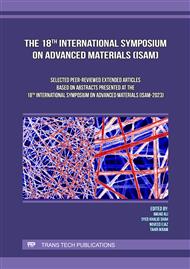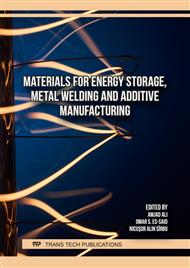[1]
M. Winter, R. J. Brodd, What are batteries, fuel cells, and supercapacitors?, Chemical reviews 104(2004)4245-4270.
DOI: 10.1021/cr020730k
Google Scholar
[2]
Zhu, Zhengxin, Rechargeable batteries for grid scale energy storage, Chemical Reviews 122 (2022).
Google Scholar
[3]
X. Qin, Y. Wang, H. Wang, H. Lin, X. Zhang, Y. Li, Z. Li, L. Wang, Reinforced concrete inspired Si/rGO/cPAN hybrid electrode: highly improved lithium storage via Si electrode nanoarchitecture engineering, Nanoscale 14 (2022) 6488-6496.
DOI: 10.1039/d2nr00278g
Google Scholar
[4]
CM. Park, J.H. Kim, H. Kim, H. J. Sohn, Li-alloy based anode materials for Li secondary batteries. Chemical Society Reviews 39(2010) 3115-3141.
DOI: 10.1039/b919877f
Google Scholar
[5]
J. W. Shim, Synergistic control of SMES and battery energy storage for enabling dispatchability of renewable energy sources, IEEE transactions on applied superconductivity 23(2013).
DOI: 10.1109/tasc.2013.2241385
Google Scholar
[6]
N.R. Chodankar, H. D. Pham, A. K. Nanjundan, J. FS. Fernando, K. Jayaramulu, D. Golberg, Y.K. Han, D.P. Dubal, True meaning of pseudocapacitors and their performance metrics: asymmetric versus hybrid supercapacitors, Small 16(2020) 2002806.
DOI: 10.1002/smll.202002806
Google Scholar
[7]
S. Suriyakumar, P Bhardwaj, AN Grace, AM Stephan, Role of polymers in enhancing the performance of electrochemical supercapacitors. a review, Batteries & Supercaps 4(2021).
DOI: 10.1002/batt.202000272
Google Scholar
[8]
R. Zhou, K.H. Lam, Development of supercapacitors with 3D porous structures, Chem ElectroChem (2024).
Google Scholar
[9]
Z. Abdullah, A. W. Anwar, I. U. Haq, Z. Arslan, A. Mubashar, S. Ahmad, A. Waheed, M. Ajmal, I. A. Baig, Synthesis of Graphene Oxide/Poly (Vinyl Alcohol) Composite and Investigation of Graphene Oxide Effect on Diameter and Pore Size of Poly (Vinyl Alcohol) Nanofibers, Journal of Nano Research 78 (2023) 23-30.
DOI: 10.4028/p-y1y1ln
Google Scholar
[10]
E. Frackowiak, Q. Abbas, F. Béguin, Carbon/carbon supercapacitors, Journal of Energy Chemistry 22(2013).
Google Scholar
[11]
M. Nasibi, M. A. Golozar, G. Rashed, Nanoporous carbon black particles as an electrode material for electrochemical double layer capacitors, Materials Letters 91(2013).
DOI: 10.1016/j.matlet.2012.09.088
Google Scholar
[12]
R. Kumar, An overview of recent progress in nanostructured carbon-based supercapacitor electrodes: From zero to bi-dimensional materials, Carbon 193(2022).
DOI: 10.1016/j.carbon.2022.03.023
Google Scholar
[13]
J.P. Zheng, P.C. Goonetilleke, C.M. Pettit, D Roy, Probing the electrochemical double layer of an ionic liquid using voltammetry and impedance spectroscopy: A comparative study of carbon nanotube and glassy carbon electrodes in [EMIM]+[EtSO4]−, Talanta 81(2010) 1045-1055.
DOI: 10.1016/j.talanta.2010.01.059
Google Scholar
[14]
Z. Zhai, L. Zhang, T. Du, B. Ren, Y. Xu, S. Wang, J. Miao, Z. Liu, A review of carbon materials for supercapacitors, Materials & Design 221(2022) 111017.
DOI: 10.1016/j.matdes.2022.111017
Google Scholar
[15]
T. Saleh, A. K. Badawi, R. S. Salama, M. Mokhtar, M. Mostafa, Design and development of novel composites containing nickel ferrites supported on activated carbon derived from agricultural wastes and its application in water remediation, Materials 16(2023) 2170.
DOI: 10.3390/ma16062170
Google Scholar
[16]
F.T. Johra, J.W. Lee, WG Jung, Facile and safe graphene preparation on solution based platform, Journal of Industrial and Engineering Chemistry 20(2014) 2883-2887.
DOI: 10.1016/j.jiec.2013.11.022
Google Scholar
[17]
M. Ana, M. G. PMS Neves, T. Trindade, Functionalization of graphene oxide with porphyrins. synthetic routes and biological applications, ChemPlusChem 85(2020).
DOI: 10.1002/cplu.202000455
Google Scholar
[18]
S. Verma, Amine-amide functionalized graphene oxide sheets as bifunctional adsorbent for the removal of polar organic pollutants, Journal of Hazardous Materials 429 (2022).
DOI: 10.1016/j.jhazmat.2022.128308
Google Scholar
[19]
Z. Liu, Preparation of monolithic polymer columns with homogeneous structure via photoinitiated thiol-yne click polymerization and their application in separation of small molecules, Analytical chemistry 86(2014).
DOI: 10.1021/ac503626v
Google Scholar



